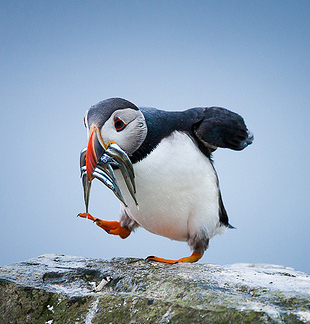Getting Outside Saturday: For the Birds
categories: Getting Outside
Comments Off on Getting Outside Saturday: For the Birds
 My latest “Wild Blog” weaves together two topics: the fate of Atlantic puffins and a great biography of Roger Tory Peterson by Doug Carlson.
My latest “Wild Blog” weaves together two topics: the fate of Atlantic puffins and a great biography of Roger Tory Peterson by Doug Carlson.
Last month, when I read that Atlantic puffins were threatened, I had an immediate and visceral reaction. It wasn’t to form a Pro-Puffin League, or to post something about saving the puffins on Facebook, or to organize a Puffin Power March on Washington. It was instead to remember the moment on that small boat off the rocky, wind-blown coast of Nova Scotia’s Cape Breton when I first saw these strange, spectacular, and, by human standards, silly-looking birds. It was a moment of surprise, intense and joyful as new sightings tend to be, and as I read about the puffins’ demise it came back to me as if it were happening again, right then and there. It had been an oddly personal encounter—though not for the birds of course: if I was anything to them it was an annoyance, some guy with binoculars staring them down. But to me they were something else entirely.
One thing they were was an invitation into a new world, and a new way of thinking about this one. I’m currently reading Roger Tory Peterson, a terrific biography by Douglas Carlson. Peterson, the founding father of modern birding and the creator of the first real birders’ field guides, grew up wandering the woods near Jamestown, New York, and from an early age took a kind of instinctive, wild joy in birds. Born in 1908, Peterson’s joy would become his profession, despite his immigrant father’s dismay that his son wasted all his time on a hobby that would never amount to everything. Enraptured, Peterson responded to the birds he saw by filling notebooks with observations, drawing and painting them, and photographing them with an ancient, unwieldy camera.
What is it about birds that captures so many of us? That moment of flight, maybe: a moment that combines the artistic and the athletic, as well as surprise. The discovery of worlds beyond the troubling human world. And the sheer vicarious pleasure of briefly getting outside of oneself.
Peterson had certainly experienced all this and more when he moved to New York City to attend art school in 1926. There he fell in with the legendary Bronx County Bird Club and their charismatic leader, Ludlow Griscom. Charging around New York to spot birds on beaches and parks and dumps, Griscom and Peterson were in the midst of a birding revolution. Before them, the way to study a bird was “in hand,” which is to say: after you had shot it. But these new birders were after something different. They called what they were looking for “field marks,” and they could see them through binoculars, often from great distances.
Before Peterson and Griscom’s time, dusty tomes filled with autopsy-inspired descriptions of birds (yet amazingly very few pictures of them) had been the norm. In 1934, the publication of Peterson’s A Field Guide to the Birds would change all that. Here, finally, was a book meant to be taken into the field, packed with clear and simple illustrations that pointed out the identifying characteristics birders should always be looking for. Notably, Peterson didn’t group birds taxonomically—which was how it had always been done before—but rather with other, similar-looking birds, in order to highlight subtle distinctions.
Peterson helped turn an activity that had previously been thought of as laborious into one that was fun. Birding was now freed from the stuffy academic halls, and the shift was reflected in the high-spirited, athletic way that Peterson and his fellow Bronx birders went chasing after the objects of their obsession, a mood they passed along to others during events like their Christmas Bird Counts and “Big Day” birding competitions. Peterson’s field guides would go on to sell more than 20 million copies.
Read the rest at OnEarth

